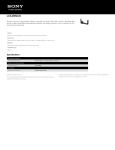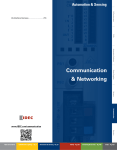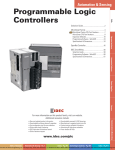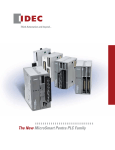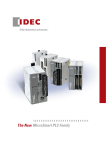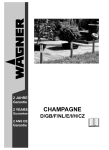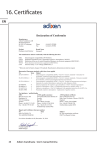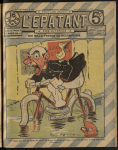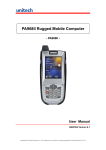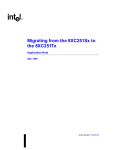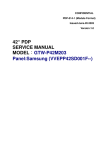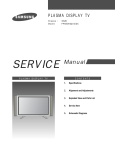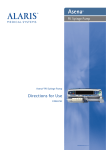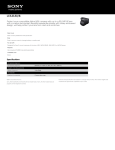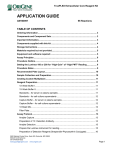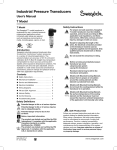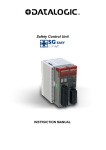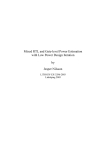Download Safe Relay Barriers Family
Transcript
Automation & Sensing
OI Touchscreens
Selection Guide........................................... 238
Discrete Input Barriers................................ 240
EB3C Discrete Input Barriers......................... 240
EB3N Discreete Input Barriers with Redundant Output
245
PLCs
Discrete Output Barriers............................. 250
EB3L Discrete Output Barriers....................... 250
General Information.................................... 264
Safety Overview.......................................... 272
Safety Components........................................ 274
Automation Software
Power Supplies
Barriers
Sensors
Communication
www.IDEC.com/barriers
Barriers
Table of Contents
LED Lighting - Pg. 1
Automation & Sensing - Pg. 27
Safety - Pg. 271
Switching & Controls - Pg. 473
Index - Pg. 973
Barriers
OI Touchscreens
Selection Guide
Selection Guide
Discrete Input Barrier
Model
EB3C-**AN
EB3C-**DN
EB3N-**D
Page
240
245
Ratings
UL/FM:Class I, II, III Div1 / Group A, B, C, D, E, F, and G
Class I, Zone 0 / [AExia] II C
NEMKO: [Exia] II C
CQST:
[Exia] II C
GOST-R: [Exia] II C
IEC Ex:
[Exia] II C
TIIS:
Discrete input barrier [Exia] IIC
Switch (EB9Z-A)
[Exia] IICT6
Switch (EB9Z-A1)
[Exia] IIBT6
NK:
[Exia] II C
KOSHA: [Exia] II C
UL:
IEC Ex:
PTB:
CQST:
TIIS:
Degree of Protection
IP20
IP20
IP20
Number of Channels
Relay Output: 1,2,3,5,6,8,10
Transistor Output: 1,2,3,5,6,8,10,16
1, 2, 3, 5, 6, 8, 10, 16
EB3N-£2ND: 2 safety circuits
EB3N-£2R5D: 2 safety circuits,
5 auxiliary circuits
Class I, II, III, Div. 1, Groups A, B,
C, D, E, F and G
Class I, Zone 0, [AExia] II C
[Exia] II C
II (1) G [Exia] II C
II (1) D [ExiaD]
[Exia] II C
[Exia] II C
Power Voltage
100 to 240V AC (UL rating: 100- 120VAC)
24V DC
24V DC
Output
Relay
Transistor
(Sink/Source)
Relay
Transistor
(Sink/Source)
Relay
Connection
Screw Terminal
Screw Terminal, Connector
Screw Terminal
Mounting
35-mm-wide DIN rail
Panel mounting
35-mm-wide DIN rail
Panel mounting
35-mm-wide DIN rail / Panel mounting
Size
(excluding projections)
42W×75H×77.5D (1 channel)
65W×75H×77.5D (2, 3 channels)
110.5W×75H×77.5D (5, 6, 8 channels (common))
171.5W×75H×77.5D (8, 10 channels)
42W×75H×77.5D (1 channel)
65W×75H×77.5D (2, 3 channels)
110.5W×75H×77.5D (5, 6, 8 channels (common))
171.5W×75H×77.5D (8, 10, 16
channels (common))
Weight (approx.)
380g (EB3C-R10AN)
390g (EB3C-R16CDN)
Barriers
Communication
Sensors
Power Supplies
Automation Software
PLCs
Appearance
238 www.IDEC.com
65.0W×75.0H×77.5D
(EB3N-£2ND)
110.5W×75.0H×77.5D
(EB3N-£2R5D)
220g (EB3N-£2ND)
300g (EB3N-£2R5D)
Barriers
Selection Guide
Discrete Output Barrier
EB3L-**AN
OI Touchscreens
Model
EB3L-**DN
Appearance
Page
250
Class I, II, III Div1 / Group A, B, C, D, E, F, and G
Class I, Zone 0 / [AExia] II C
[Exia] II C
[Exia] II C
[Exia] II C
[Exia] II C
Discrete output barrier [Exia] II C
[Exia] II C
[Exia] II C
IP20
Number of Channels
1, 2, 3, 5, 6, 8, 10
1, 2, 3, 5, 6, 8, 10, 16
Power Voltage
100 to 240V AC (UL rating: 100 ~ 120V AC)
24V DC
Input
Transistor input (sink)
Transistor input (source)
Transistor input (sink)
Transistor input (source)
Connection
Screw Terminal
Screw Terminal, Connector
Mounting
35-mm-wide DIN rail
Panel mounting
35-mm-wide DIN rail
Panel mounting
Size
(excluding projections)
42W×75H×77.5D (1 channel)
65W×75H×77.5D (2, 3 channels)
110.5W×75H×77.5D (5, 6, 8 channels)
171.5W×75H×77.5D (8, 10 channels)
42W×75H×77.5D (1 channel)
65W×75H×77.5D (2, 3 channels)
110.5W×75H×77.5D (5, 6, 8 channels)
171.5W×75H×77.5D (8, 10, 16 channels (common))
Weight (approx.)
360g (EB3L-S10SAN)
360g (EB3L-S16CSDN)
Power Supplies
IP20
Automation Software
Degree of Protection
PLCs
Ratings
UL/FM:
NEMKO:
CQST:
GOST-R:
IEC Ex:
TIIS: NK: KOSHA: Sensors
Communication
Barriers
800-262-IDEC (4332) • USA & Canada
239
Barriers
OI Touchscreens
EB3C
Intrinsically Safe: EB3C Discrete Input Barriers
Key features:
• Applicable Standards
IEC60079 compliant
Automation Software
PLCs
Switch (EB9Z-A): Switch (EB9Z-A1): [Exia] II C Exia II CT6 Exia II BT6
• Dry-contact switches can be connected to the EB3C
• 8- and 16-circuit types are available in common wiring types, ideal
for connection to PLCs (DC voltage only)
• Universal AC power voltage (100 to 240V AC) or
24V DC power (UL rating: 100 ~ 120V AC)
• No grounding required
• IDEC’s original spring-up terminals minimizes wiring time
• Installation: 35-mm-wide DIN rail mounting or direct panel mounting
• Global usage
USA: UL/FM
Europe: CE marking, ATEX IECEx
Japan: TIIS
Korea: KOSHA
• Ship class: NK (Japan), KR (Korea)
FM
LISTED
A P P ROV E D
Entity Ratings and Parameters
Sensors
Power Supplies
Ta= 60°C, Um= 125V, Uo=13.2V, Io= 14.2mA, Po= 46.9mW at each channel Pn-Nn Io=227.2mA, Po= 750mW at max 16 channels Pn-Nn
28.4
42.6
56.8
71.0
85.2 99.4 113.6 127.8 142.0 156.2 170.4 184.6
198.8
213.0 227.2 Combined
Io(mA) 14.2
Po(mW) 46.9
93.8
140.6 187.5
234.3
281.2 328.1 375.9 421.8 468.7 515.5 562.4 609.2
656.1
702.9 750 Lo(mH)
0.67
0.65
0.63
0.61
0.59
0.57 0.55 0.53
0.51
0.49
0.47
0.44
0.42
0.39
1.0
0.79
0.77
0.76
0.75
0.73
0.72 0.70 0.69
0.67
0.66
0.64
0.62
0.61
0.59
0.57 0.55 0.5
Co(μF)
0.94
0.94
0.94
0.94
0.94
0.94 0.94 0.93
0.92
0.91
0.90
0.88
0.87
0.86
0.85 0.84 0.2
0.94
0.94
0.94
0.94
0.94
0.94 0.94 0.94
0.94
0.94
0.94
0.94
0.94
0.94
0.94 0.94 0.1
Note 1 Added to above table, the next values combined Lo and Co are allowable;
Io(mA)
14.2
28.4
227.2
Lo(mH) 175*
87.5
30.0
2.5
0.55
0.25 43.5* 21.5
20.0
3.5
0.43
0.25
0.68*
0.34
0.68 0.6 0.22 0.13
0.45
0.33
0.54
0.77
0.90 0.90* 0.45
0.30
0.48
0.80
0.90
0.90*
0.45
0.45 0.49 0.80 0.90
Co(µF) 0.90*
Note 2 The intrinsic safe apparatus and wirings shall be accordance to following formulas; for example: Ui > Uo Ii > Io Pi > Po Ci+Cc < Co Li+Lc < Lo
*: Therefore, the values are allowable only at Li<1%Lo and Ci<1%Co of the intrinsic safe apparatus. (In the case of 50% of Co and Lo parameters are applicable,the maximum
capacitance allowed shall not be more than Co = 1 µF for IIB and Co= 600 nF for IIC.)
Spring-up Fingersafe Terminals Reduce
Wiring Time
Dry Contact Switches
Dry-contact switches can be connected to the EB3C.
Communication
Finger-safe
LB Series
CW Series
HW Series
Common Wiring for PLC Inputs
8- and 16-circuit types are available in common wiring types, ideal for connection to PLCs (DC voltage
only).
Barriers
Connector Type
MIL connector on the non-hazardous side
• Easy connection to PLCs
• Wiring is cut by 90% (compared with IDEC’s
16-circuit EB3C)
• Various 20-pin MIL connectors can be connected
240 www.IDEC.com
Barriers
EB3C
General Specifications
Ratings
See Certification Numbers table below
Degree of Protection
IP20 (IEC60529)
Installation
Location
Electrical Specifications
Safe indoor place
(non-hazardous area)
DC
Rated Voltage
100 to 240V AC
(UL rating: 100 ~ 120V AC)
24V DC
Allowable Voltage Range
85 to 264V AC
(UL rating: 85 ~ 125V AC)
21.6 to 26.4V DC
250V AC 50/60Hz, 250V DC
125V AC 50/60Hz, 125V DC (UL rating)
Rated Frequency
50/60 Hz (allowable range:
47 to 63 Hz)
—
Inrush Current
10A (100V AC)
20A (200V AC)
10A
Wiring Method
1-channel
Separate
Wiring
Rated Operating Voltage
12V DC ±10%
Rated Operating Current
10 mA DC ±20%
Intrinsically
Safe Circuits
Non-intrinsically Safe Circuit
Maximum Voltage (Um)
1NO
Rated Insulation Voltage (Ui)
250V AC (UL rating: 125V AC), 125V DC
Thermal Current (lth)
3A (common terminal: 8A)
Relay Output
Dielectric Strength
(1 minute, 1 mA)
Between AC power and output terminal: 1500V AC
Between DC power and transistor output terminal:
1526.4V AC
Operating Temperature
–20 to +60°C (no freezing)
Storage Temperature
–20 to +60°C (no freezing)
Operating Humidity
45 to 85% RH (no condensation)
Resistive Load
AC: 750 VA, DC: 72W
Inductive Load
AC: 750 VA (cos ø = 0.3 to 0.4)
DC: 48W (L/R = 7 ms)
Atmosphere
800 to 1100 hPa
Resistive Load
250V AC 3A, 24V DC 3A
Pollution Degree
2 (IEC60664)
Inductive Load
250V AC 3A (cos ø = 0.3 to 0.4)
24V DC 2A (L/R = 7 ms)
Insulation Resistance
10 MΩ minimum (500V DC megger, between the
same poles as the dielectric strength)
Contact Resistance
50 mΩ
ON Time
12 ms maximum (rated voltage)
OFF Time
10 ms maximum (rated voltage)
Mechanical Life
20,000,000 operations minimum (at
18,000 operations/hour, without load)
Electrical Life
100,000 operations minimum
(at 1,800 operations/hour, rated load)
Short-circuit Protection
None
Rated Voltage
24V DC
Maximum Voltage
30V DC
Maximum Current
100 mA (connector type: 15 mA)
Leakage Current
0.1 mA maximum
Voltage Drop
1V maximum
Clamping Voltage
33V (1W)
Inrush Current
0.5A maximum (1 sec)
ON Time
0.1 ms maximum (resistive load)
OFF Time
0.4 ms (typical) (resistive load)
Short-circuit Protection
None
Values in ( ) are those approved by TIIS (Technology Institution of Industrial Safety, Japan).
Note: Um = 125V AC for UL ratings
Vibration
Resistance
Damage Limits
Operation Extremes
(relay output only)
Panel mounting: 10 to 55 Hz, amplitude 0.75 mm
DIN rail mounting: 10 to 55 Hz, amplitude 0.35 mm
Panel mounting: 10 to 55 Hz, amplitude 0.5 mm
DIN rail mounting: 10 to 55 Hz, amplitude 0.35 mm
Shock
Damage Limits
Resistance
Panel mounting: 500 m/s² (3 times each on X, Y, Z)
Terminal Style
M3 screw terminal
Mounting
35-mm-wide DIN rail or panel mounting (M4 screw)
Power Consumption (approx.)
9.6 VA (EB3C-R10AN at 200V AC)
4.8 W (EB3C-R16CDN at 24V DC)
Weight (approx.)
390g (EB3C-R16CDN)
DIN rail mounting: 300 m/s² (3 times each on X, Y, Z)
Certification Numbers
Certification
Organization
UL/FM
Ratings
Class I, II, III Div. 1
Groups A, B, C, D, E, F and G
Class I, Zone 0 AEx [ia] IIC
Certification
Number
3047250
UL file: E234997
CSA
Class I Div. 1 Groups A, B, C, D
166730
PTB (ATEX)
[Exia] II C: Gas, Vapour [Exia] III C: Dust
PTB09 ATEX2046
PTB (IEC-EX)
[Exia] II C: Gas, Vapour [Exia] III C: Dust
IECEx PTB10.0015
NEMKO
[Exia] II C
Nemko 02ATEX279
TIIS Japan
Relay barrier: [Exia] II C
TC15753
Class NK
[Exia] II C
02T606
CQST
[Exia] II C
CNEx10.2445
Communication
0.1V DC, 0.1 mA (reference value)
Sensors
Minimum Applicable Load
Power Supplies
Transistor Output
Rated Load
Between intrinsically safe circuit and non-intrinsically safe circuit: 1526.4V AC
Automation Software
Contact Configuration
Contact
Allowable
Power
Non-intrinsically Safe Circuits
16-channel
Common Wiring
PLCs
AC
Discrete Input Barrier
OI Touchscreens
Specifications
Class NK is Japan Shipping agency approval, Class KR is Korean shipping agency approval.
Barriers
800-262-IDEC (4332) • USA & Canada
241
Barriers
OI Touchscreens
EB3C
Part Numbers
Discrete Input Barriers
Power Voltage
Connection to
Non-intrinsically
Safe Circuit
Input Wiring Method
Number of
Channels
Output
Separate/Common Wiring
Compatible
PLCs
Relay
Common Wiring Only
100 to 240V AC
(UL rating: 100 ~
120V AC)
Automation Software
Separate/Common Wiring
Compatible
Transistor (Sink/Source)
Sink
Common Wiring Only
Transistor
Source
Power Supplies
Screw Terminal
Separate/Common Wiring
Compatible
Relay
Sensors
Common Wiring Only
24V DC
Separate/Common Wiring
Compatible
Transistor (Sink/Source)
Sink
Communication
Common Wiring Only
Transistor
Connector
Source
Sink
Connector Wiring
Source
*Note: These models are NOT Listed by UL
Accessories
Barriers
Item
DIN Rail
Part Number
BAP1000
Description
Steel (1m long, 7.5mm high)
BAA1000
Aluminum (1m long, 10.5mm high)
End Clip
BNL6
Medium DIN rail end clip
Static Electricity Caution Plate
EB9Z-N1
Polyester 20 (W) x 6 (H) mm
242 www.IDEC.com
Part Number
Weight
(approx) g
1
EB3C-R01AN
150
2
EB3C-R02AN
180
3
EB3C-R03AN
190
5
EB3C-R05AN
260
6
EB3C-R06AN
270
8
EB3C-R08AN
300
10
EB3C-R10AN
380
8
EB3C-R08CAN
280
1
EB3C-T01AN
140
2
EB3C-T02AN
170
3
EB3C-T03AN
180
5
EB3C-T05AN
250
6
EB3C-T06AN
260
8
EB3C-T08AN
320
10
EB3C-T10AN
340
8
EB3C-T08CKAN*
260
16
EB3C-T16CKAN*
260
8
EB3C-T08CSAN
260
16
EB3C-T16CSAN
260
1
EB3C-R01DN
130
2
EB3C-R02DN
170
3
EB3C-R03DN
180
5
EB3C-R05DN
250
6
EB3C-R06DN
260
8
EB3C-R08DN
260
10
EB3C-R10DN
360
8
EB3C-R08CDN
270
16
EB3C-R16CDN
390
1
EB3C-T01DN
120
2
EB3C-T02DN
160
3
EB3C-T03DN
170
5
EB3C-T05DN
240
6
EB3C-T06DN
250
8
EB3C-T08DN
250
10
EB3C-T10DN
320
8
EB3C-T08CKDN*
250
16
EB3C-T16CKDN*
350
8
EB3C-T08CSDN
250
16
EB3C-T16CSDN
350
EB3C-T16CKD-CN*
330
EB3C-T16CSD-CN
330
16
Barriers
EB3C
Internal Circuit Block Diagrams
AC Power, Relay Output Type
DC Power, Transistor Output Type
Connector Wiring, Sink Output Type
Hazardous Area
••••••••
P1 N1
Green
P2 N2
Yellow
P1 N1
P3 N3
Yellow
Yellow
Yellow
Green
P3 N3
Yellow
P1 • • • • P16 N1
Yellow
+
A1 C1 A2 C2 A3 C3
N2
Non-hazardous Area
Yellow
PLCs
N
Yellow
Green
~~
~
~
L
P2 N2
OI Touchscreens
Circuit Diagrams
~~
~
–
A1 C1 A2 C2 A3 C3
+
–
A1 • • • • A16 C1 C2
Automation Software
Wiring Examples
External Wiring Examples
Transistor Source Output Type (Ex.: EB3C-T08CSDN)
A2
A3
A4
A5
A6
A7
A8
C1
C2
Load Power
24V DC
Load
Load
A1
Load
N2
Load
N1
Load
P8
N3
P4
N4
P5
N5
P6
N6
A1
C1
A2
C2
A3
C3
A4
C4
A5
C5
A6
C6
L
Load
Load
Power
AC/DC
N3
P4
N4
P5
N5
P6
N6
N
A1
C1
A2
C2
A3
C3
A4
C4
A5
C5
A6
C6
AC Power
Load
P3
Load
N2
Load
P2
Load
N1
Load
P1
Load
P3
Load
N2
Load
P2
Load
N1
Load
P7
Communication
AC Power
P6
Transistor Output Type (Ex.: EB3C-T06AN)
P1
Load
N
P5
Sensors
L
P4
Load
24V DC
Relay Output Type (Ex.: EB3C-R06AN)
P3
Load
–
P2
Power Supplies
+
P1
Load
Transistor Sink Output Type (Ex.: EB3C-T08CKDN)
Load
Power
24V DC
Barriers
800-262-IDEC (4332) • USA & Canada
243
Barriers
EB3C
ø6 hole
77.5
171.5
77.5
65
61
171.5
110.5
(4)
4
6
4
6
77.5
77.5
PLCs
(4)
ø6 hole
10
10
10
10
10
10
10
10
51
97
51
28
97
4-M4 tapped or
4-ø4.5 mounting holes
97
97
65
4-M4 tapped or
2-M4 tapped or 4-ø4.5 mounting holes
2-ø4.5 mounting holes
Applicable Crimping Terminal
ø3.2 min.
Applicable Crimping Terminal
6 max.
6 max.
28
2-M4 tapped or
2-M4 tapped
2-ø4.5ormounting holes
2-ø4.5 mounting holes
65
2-M4 tapped
or
2-M4 tapped
or
2-ø4.52-ø4.5
mounting
holes
mounting
holes
65
2-M4 tapped or
2-ø4.5 mounting
holes
ø3.2 min.
Applicable
Crimping
Terminal
Applicable
Terminal
3 max. Crimping
5.4
min.
EB3C–T16C-CN
3 max.
171.5
(4)
83.5
ø3.2 min.
5.4 min.
Stripping
the Wire End
3 max.
Stripping
Solidthe
WireWire End
4-M4 or 4-ø4.5 holes
65
75
4- ø4.5 holes
65
ø6
6 max.
Connector
Connector
Power Supplies
10
Mounting Hole
(Screw
Mounting)
Mounting
HoleLayout
Layout
(Screw
Mounting)
Mounting Hole Layout (Screw Mounting)
65
Automation Software
10
Solid Wire
Solid
Wire - Strip wire end
Stripping the Wire
6 to 8End
mm
Stranded Wire
(Ferrule)
Stranded
Wire
6 to- use
8 mma ferrule
Stranded Wire (Ferrule)
77.5
6 to 8 mm
Stranded Wire
6 to(Ferrule)
8 mm
6
6 to 8 mm
97
10
Barriers
Communication
10
244 5.4 min.
Solid Wire 6 to 8 mm
97
Mounting Hole Layout
Sensors
ø4.4
110.5
65
42
EB3C–*08N
EB3C–*10N
EB3C–*16CN
65
65
61
75
42
EB3C–*08N
EB3C–*05N EB3C–*10N
EB3C–*06N EB3C–*16CN
EB3C–*08NC
ø4.4
EB3C–*02N
EB3C–*03N
EB3C–*01N
EB3C–*01N
75
OI Touchscreens
Dimensions (mm)
EB3C–*05N
EB3C–*06N
EB3C–*02N
EB3C–*08NC
EB3C–*03N
www.IDEC.com
Barriers
EB3N
OI Touchscreens
EB3N Discrete Input Barrier with Redundant Output
Build a safety system in an explosive atmosphere.
Key features:
Safety Performance
Performance level e Category 4
PLCs
Automation Software
• [Exia] II C
• Ensures safety and machine safety in an explosive atmosphere
• Machine safety system can be built in compliance with ISO13849-1 Category 4,
Performance level e
• Illuminated pushbuttons and illuminated selector switches can be connected by
combining with the EB3C relay barrier.
• Illumination colors: Amber, blue, green, red, white, and yellow (pushlock turn
reset type: red only)
• Safety input devices applicable in any explosive gas and hazardous areas are
available.
• Available with auxiliary inputs (5 points) used to monitor the operating status of
safety input devices
• Global usage
Japan (TIIS),
USA (UL),
Europe (ATEX),
Machine safety:TÜV Rheinland
• No grounding required
IEC Ex
LISTED
Entity Ratings and Parameters
Ta= 60°C, Um= 125V, Uo=13.2V, Io= 14.2mA, Po= 46.9mW at each channel Pn-Nn Io=227.2mA, Po= 750mW at max 16 channels Pn-Nn
Power Supplies
28.4
42.6
56.8
71.0
85.2 99.4 113.6 127.8 142.0 156.2 170.4 184.6
198.8
213.0 227.2 Combined
Io(mA) 14.2
Po(mW) 46.9
93.8
140.6 187.5
234.3
281.2 328.1 375.9 421.8 468.7 515.5 562.4 609.2
656.1
702.9 750 Lo(mH)
0.67
0.65
0.63
0.61
0.59
0.57 0.55 0.53
0.51
0.49
0.47
0.44
0.42
0.39
1.0
0.79
0.77
0.76
0.75
0.73
0.72 0.70 0.69
0.67
0.66
0.64
0.62
0.61
0.59
0.57 0.55 0.5
Co(μF)
0.94
0.94
0.94
0.94
0.94
0.94 0.94 0.93
0.92
0.91
0.90
0.88
0.87
0.86
0.85 0.84 0.2
0.94
0.94
0.94
0.94
0.94
0.94 0.94 0.94
0.94
0.94
0.94
0.94
0.94
0.94
0.94 0.94 0.1
Note 1 Added to above table, the next values combined Lo and Co are allowable;
Io(mA)
14.2
28.4
227.2
Lo(mH) 175*
87.5
30.0
2.5
0.55
0.25 43.5* 21.5
20.0
3.5
0.43
0.25
0.68*
0.34
0.68 0.6 0.22 0.13
0.45
0.33
0.54
0.77
0.90 0.90* 0.45
0.30
0.48
0.80
0.90
0.90*
0.45
0.45 0.49 0.80 0.90
Co(µF) 0.90*
Note 2 The intrinsic safe apparatus and wirings shall be accordance to following formulas; for example: Ui > Uo Ii > Io Pi > Po Ci+Cc < Co Li+Lc < Lo
*: Therefore, the values are allowable only at Li<1%Lo and Ci<1%Co of the intrinsic safe apparatus. (In the case of 50% of Co and Lo parameters are applicable,the maximum
capacitance allowed shall not be more than Co = 1 µF for IIB and Co= 600 nF for IIC.)
Sensors
Discrete Input Barrier with Redundant Output
Safety Output Points
Auxiliary Input Points 1
Auxiliary Output Points (Relay Output)
2
2NO
Without
Without
2
2NO
5 (1 common)
5NO (1 common)
Reset (Start) 2 3
Part Number
Auto reset (Auto start)
EB3N-A2ND
Manual reset (Manual start)
EB3N-M2ND
Auto reset (Auto start)
EB3N-A2R5D
Manual reset (Manual start)
EB3N-M2R5D
Communication
Safety Input Points
800-262-IDEC (4332) • USA & Canada
Barriers
1. A maximum of five monitor contacts from safety input devices can be connected to the auxiliary input terminals. In addition, non-safety input devices can also be connected to the auxiliary input
terminals.
2. On auto reset (auto start) models, when the safety condition is met (two safety inputs are both on), safety outputs are turned on automatically.
Connect the reset (start) input terminals Y1 and Y2 together except for the following cases:
When connecting a contactor or force guided relay to the safety output of the EB3N, connect the NC contacts of the contactor or force guided relay to the reset (start) input terminals Y1 and Y2 of the
EB3N for use as a backcheck input signal.
3. On manual reset (manual start) models, while the safety condition is met (two safety inputs are both on), safety outputs are turned on at the falling edge of the reset switch (start switch) signal
(OFF ON OFF) (start off check).
Manual reset (manual start) models have a monitoring function of reset switch contacts (detection of welded contacts). Use NO contacts of a momentary switch for the reset (start) input.
When connecting a contactor or force guided relay to the safety output of the EB3N, connect the NC contacts of the contactor or force guided relay to the reset (start) input terminals Y1 and Y2 of the
EB3N for use as a backcheck input signal.
245
Barriers
EB3N
OI Touchscreens
Selection Guide
1. Selecting the reset (start) function
Auto reset (auto start):
Select this model when connecting safety control devices, such as safety relay modules or safety controllers, to the EB3N safety
outputs to set up a safety system, using the reset (start) function of the safety control device.
PLCs
Manual reset (manual start):
Select this model when connecting contactors or force guided relays to the EB3N safety outputs to set up a safety system, and a
risk assessment on the entire system has not found any safety problem in using auto reset (auto start).
Select this model when connecting contactors or force guided relays to the EB3N safety outputs to set up a safety system, and a
risk assessment on the entire system has found that manual reset (manual start) is necessary.
2. Selecting the auxiliary outputs
Without auxiliary outputs:
Select this model when the operating status of safety input devices are not monitored.
With auxiliary outputs:
Select this model when the operating status of safety input devices are monitored or when non-safety input devices are also connected.
Specifications
Power Supplies
Automation Software
General
24V DC
Category
4
Power Voltage Range
20.4 to 26.4V DC
Performance Level (PL)
e
Operating Temperature
–20 to +60°C (no freezing)
UL: –20 to +40°C
(no freezing)
Mean Time to Dangerous Failure (MTTFd)
100 years
Diagnostic Range
99% minimum
Operating Humidity
45 to 85% RH
(no condensation)
Power
Consumption
Safety
Output
Auxiliary
Output
Sensors
Safety
Rated Power Voltage
Calculation conditions for MTTFd
tcycle: Mean operation cycle = 1 hour
hop:Mean operation hours per day = 24 hours
dop:Mean operation days per year = 365 days
Note: When tcycle is shorter than 1 hour, MTTFd will decrease
Without auxiliary output
5.5W maximum
With auxiliary output
7.0W maximum
Contacts
13-14, 23-24
2NO
Resistive
30V DC, 1A
Inductive
DC-13, 24V, 1A
Response
(rated voltage)
Turn on
100 ms maximum
Turn off
20 ms maximum
Contacts
A* - C1
5NO/1 common
Rated Load
Resistive
24V DC, 3A,
common terminal 5A max.
Response
(rated voltage)
Turn on
15 ms maximum
Turn off
10 ms maximum
Rated Load
Mounting
DIN rail or panel mounting
*: Channel Numbers: 1 to 5
Communication
Certifications
Certification
Organization
Ratings
TIIS
Discrete Input Barriers with Redundant Output
Switch (EB9Z-A)
Exia II CT6
Switch (EB9Z-A1)
Exia II BT6
PTB
[Exia] II C
TC18753
TC15758
T15961
[Exia] II C, [Exia D]
IEC Ex PTB 10.0015
II (1) G [Exia] II C
II (1) D [Exia D]
PTB 09 ATEX 2046
Class I, Zone 0, [AExia] II C
Class I, II, III, Div. 1, Groups A, B, C, D, E, F and G
E234997
Barriers
UL
Certification Number
246 www.IDEC.com
Barriers
EB3N
EB3N-A2ND
EB3N-M2ND
Terminal Functions
EB3N-A2R5D
EB3N-M2R5D
65.0
77.5
75.0
75.0
110.5
EB3N-A2R5D
EB3N-M2R5D
24V DC
Power
Y1-Y2
Reset input (Start input)
11-12
Safety input 1
21-22
Safety input 2
N1, N2
Signal ground
P*-N3
Auxiliary input
13-14
Safety output 1
23-24
Safety output 2
A*-C1
Auxiliary output
PLCs
Mounting Hole Layout
EB3N-A2ND
EB3N-M2ND
OI Touchscreens
Dimensions (mm)
2-M4 tapped or
2-ø4.5 drilled holes
Automation Software
51
65
2-M4 tapped or
2-ø4.5 drilled holes
65
*: 1 to 5
97
EB3N System Configuration Examples
1:1 connection with a safety input device, compliant with Category 4
Hazardous Area
Non-hazardous Area
EB3N-A2ND
Safety Input Device
Barrier Safety Output Safety Control Device
Safety Output
Safety Contactor
• A safety relay module or safety controller
is used to set up a safety circuit, using
the reset (start) function of the safety
relay module or safety controller.
Power Supplies
Backcheck Input
Reset (Start) Input
Safety Input Device
EB3N-M2ND
• The reset (start) function is used to set up
a safety circuit, without using a safety
relay module or safety controller.
Barrier Safety Output Safety Contactor
Backcheck Input
Reset (Start) Input
Connection with multiple safety input devices, capable of monitoring up to 5 contact operations, compliant with Category 3
For monitoring operating statuses of safety input devices located in a non-hazardous area
Hazardous Area
Non-hazardous Area
Safety Control Device
Safety Output
Barrier Safety Output
Safety Contactor
EB3N-A2R5D
Safety Input Devices
Connected in Series
Backcheck Input
• A safety relay module or safety controller
is used to set up a safety circuit, using
the reset (start) function of the safety
relay module or safety controller.
Barrier Safety Output
Safety Input Devices
Connected in Series
Reset (Start) Input
Auxiliary Output
(Monitor Output)
Monitor
Safety Contactor
EB3N-M2R5D
Backcheck Input
Reset (Start) Input
…
Monitor
Sensors
PLC
…
PLC
• The manual reset (manual start) function
of the EB3N is used to set up a safety
circuit, without using a safety control
device.
Communication
Auxiliary Output
(Monitor Output)
Barriers
800-262-IDEC (4332) • USA & Canada
247
Barriers
EB3N
OI Touchscreens
Installing a reset switch in a hazardous area, using auxiliary input and output
Hazardous Area
Non-hazardous Area
Barrier Safety Output
Safety Input Devices
Safety Output
Safety Control Device
…
Safety Contactor
EB3N-A2R5D
Reset (Start) Switch
Reset (Start) Output
Backcheck Input
PLC
Other Input Device
Other Output
Barrier Safety Output
Safety Input Devices
PLCs
Safety Contactor
EB3N-M2R5D
Reset (Start) Switch
Backcheck Input
PLC
Other Input Device
Reset (Start) Input
Communication
Sensors
Power Supplies
Automation Software
Other Output
Safety Input Devices Connectable to Safety Input Terminals (Examples)
Emergency stop switch:
Safety switch:
(Non-illuminated) XW1E, XN4E
HS6B-02B05, HS1B-02R
Instructions
Notes for Operation
Notes for Machine Safety
1. Do not disassemble, repair, or modify the EB3N discrete input barrier with
redundant output, otherwise the safety characteristics may be impaired.
1. Operate the safety input device to check the EB3N functionality everyday.
2. Use the EB3N within its specification values.
3. The EB3N can be mounted in any direction.
4. Mount the EB3N on a 35-mm-wide DIN rail or directly on a panel surface using screws. When mounting on a DIN rail, push in the clamp and use end clips
to secure the EB3N. When mounting on a panel surface, tighten the screws
firmly.
5. Excessive noise may cause malfunction or damage to the EB3N. When the
internal voltage limiting circuit (thyristor) has shut down the power due to
noise, remove the cause of the noise before powering up again.
6. The internal power circuit contains an electronic fuse to suppress overcurrents. When the electronic fuse has tripped, shut down the power, remove the
cause of the overcurrent before powering up again.
2. For safety input devices, such as safety switches or emergency stop switches,
connected to the EB3N, use safety standard-compliant devices with direct
opening action and 2NC contacts.
3. Do not use the auxiliary input as a safety input.
4. For safety control devices connected with the EB3N, use machine safety
standard-compliant devices with a disparity detection function.
5. Use safety inputs and safety outputs in a circuit configuration compliant with
safety requirements.
6. To calculate the safety distance, take into consideration the response time
of all devices comprising the system, such as the EB3N and safety devices
connected to the EB3N.
7. Separate the input and output wiring from power lines and motor lines.
7. Use crimping terminals with insulation sheath for wiring. Tighten the terminal
screws, including unused terminal screws, to a recommended tightening
torque of 0.6 to N·m using a screwdriver of ø5.5 mm in diameter.
8. When using multiple EB3N discrete input barriers with redundant output, do
not connect one switch to more than one EB3N. Use separate switches for
each EB3N.
8. Before inspecting or replacing the EB3N, turn off the power.
9. To ensure EMC, use shielded cables for safety inputs and auxiliary inputs.
Connect the shield to the FG of the control panel on which the EB3N is
mounted.
10. For protection against overcurrents, connect an IEC60127-2-compliant 2A
fast-blow fuse (5 × 20 mm).
Barriers
11. Evaluate the ISO 13849-1 category and performance level in consideration of
the entire system.
248 www.IDEC.com
Barriers
EB3N
Switches in the Hazardous Area
1. Install the EB3N in an enclosure capable of protecting against mechanical
shocks at a hazardous location in accordance with intrinsic safety ratings and
parameters.
1. A switch contains the switch contact, enclosure, and internal wiring. A switch
contact refers to an ordinary switching device which consists of contacts only.
2. When the switch has internal wiring or lead wire, make sure that the values
of internal capacitance (Ci) and inductance (Li) are within the certified values.
3. Enclose the bare live part of the switch contact in an enclosure of IP20 or
higher protection.
PLCs
2. Install and wire the EB3N so that the EB3N is not subject to electromagnetic
and electrostatic induction and does not contact with other circuits.
For example, keep a minimum spacing of 50 mm between intrinsically safe
and non-intrinsically safe circuits, or provide a metallic separating board
between the intrinsically safe circuit and non-intrinsically safe circuit. When
providing a metallic separating board, make sure that the board fits closely to
the enclosure (top, bottom, and both sides). Allowable clearance between the
board and the enclosure is 1.5 mm at the maximum.
When a motor circuit or high-voltage circuit is installed nearby, keep a wider
spacing than 50 mm between intrinsically safe and non-intrinsically safe
circuits.
OI Touchscreens
Safety Notes
Automation Software
3. Keep a minimum spacing of 3 mm between the terminal or relay terminal
block of the intrinsically safe circuit and the grounded metal parts of the
metal enclosure.
4. Connect the terminals so that IP20 is ensured.
5. To prevent disengaged wires from contacting with other intrinsically safe
circuits, bind together the end of wires.
6. Make sure that the voltage of the power supply for the devices connected to
the non-intrinsically safe circuit or the internal voltage of such devices does
not exceed 250V AC/DC 50/60 Hz (UL rating: 125V AC 50/60 Hz) or 250V DC
(UL rating: 200V DC) under any normal and abnormal conditions.
Power Supplies
7. Make sure that the wiring of intrinsically safe circuits does not contact with
other circuits or is not subject to electromagnetic and electrostatic inductions,
otherwise protection from hazards is not ensured.
8. When identifying intrinsically safe circuits by color, use light blue terminal
blocks and cables.
Sensors
9. When wiring the intrinsically safe circuit, determine the distance to satisfy
the wiring parameters shown below.
a) Wiring capacitance Cw ≤ Co – Ci
Co: Intrinsically safe circuit allowable capacitance
Ci:
Internal capacitance of switches
b) Wiring inductance Lw ≤ Lo – Li
Lo:
Intrinsically safe circuit allowable inductance
Li:
Internal inductance of switches
c) Wiring resistance ≤ Rw
Rw:
Allowable wiring resistance
Communication
Barriers
800-262-IDEC (4332) • USA & Canada
249
Barriers
EB3L
OI Touchscreens
EB3L Discrete Output Barriers
126 types of pilot lights and buzzers can be connected. Illuminated pushbuttons and
illuminated selector switches can be connected by combining with the EB3C discrete
input barrier. No grounding required.
Key features:
Communication
Sensors
Power Supplies
Automation Software
PLCs
Ratings
Discrete Output Barrier
[Exia] II C
Pilot Light (separate wiring)
Exia II CT6
Pilot Light (common wiring)
Exia II CT4
Illuminated Pushbutton
Exia II CT4
Illuminated Selector Switch
Exia II CT4
Buzzer (separate wiring)
Exia II CT6
• IEC60079 compliant
• Compact and lightweight
• 8- and 16-channel types are available in common wiring types, ideal for connection
to PLCs. 16-circuit types are also available with a connector.
• Universal AC power voltage (100 to 240V AC or 24V DC power
[UL rating: 100 ~ 120V AC])
• No grounding required
• IDEC’s original spring-up terminal minimizes wiring time.
• Installation, 35-mm-wide DIN rail mounting or direct screw mounting
• ø6, ø8, ø10, ø22 and ø30 pilot lights available
• Illuminated pushbuttons and illuminated selector switches can be connected by combining with the EB3C discrete input barrier. Illumination colors: Amber, blue, green,
red, white, and yellow (pushlock turn reset type: red only)
• Continuous and intermittent sound types are available for buzzers (ø30).
• Global usage
USA:UL/FM
Europe: CE marking, ATEX, IECEx
Russia: vCOST R
Japan:TIIS
Korea:KOSHA
• Ship class: NK (Japan), KR (Korea)
LISTED
Illuminated Pushbutton/Selector Switches
Illuminated pushbutton/selector switches can be used
with the combination of EB3C and EB3L.
Spring-up Fingersafe Terminals Reduce
Wiring Time
Finger-safe
Entity Ratings and Parameters
Ta= 60°C, Um= 125V, Uo=13.2V, Io= 14.2mA, Po= 46.9mW at each channel Pn-Nn Io=227.2mA, Po= 750mW at max 16 channels Pn-Nn
28.4
42.6
56.8
71.0
85.2 99.4 113.6 127.8 142.0 156.2 170.4 184.6
198.8
213.0 227.2 Combined
Io(mA) 14.2
Po(mW) 46.9
93.8
140.6 187.5
234.3
281.2 328.1 375.9 421.8 468.7 515.5 562.4 609.2
656.1
702.9 750 Lo(mH)
0.67
0.65
0.63
0.61
0.59
0.57 0.55 0.53
0.51
0.49
0.47
0.44
0.42
0.39
1.0
0.79
0.77
0.76
0.75
0.73
0.72 0.70 0.69
0.67
0.66
0.64
0.62
0.61
0.59
0.57 0.55 0.5
Co(μF)
0.94
0.94
0.94
0.94
0.94
0.94 0.94 0.93
0.92
0.91
0.90
0.88
0.87
0.86
0.85 0.84 0.2
0.94
0.94
0.94
0.94
0.94
0.94 0.94 0.94
0.94
0.94
0.94
0.94
0.94
0.94
0.94 0.94 0.1
Note 1 Added to above table, the next values combined Lo and Co are allowable;
Io(mA)
14.2
28.4
227.2
Lo(mH) 175*
87.5
30.0
2.5
0.55
0.25 43.5* 21.5
20.0
3.5
0.43
0.25
0.68*
0.34
0.68 0.6 0.22 0.13
0.45
0.33
0.54
0.77
0.90 0.90* 0.45
0.30
0.48
0.80
0.90
0.90*
0.45
0.45 0.49 0.80 0.90
Co(µF) 0.90*
Note 2 The intrinsic safe apparatus and wirings shall be accordance to following formulas; for example: Ui > Uo Ii > Io Pi > Po Ci+Cc < Co Li+Lc < Lo
*: Therefore, the values are allowable only at Li<1%Lo and Ci<1%Co of the intrinsic safe apparatus. (In the case of 50% of Co and Lo parameters are applicable,the maximum
capacitance allowed shall not be more than Co = 1 µF for IIB and Co= 600 nF for IIC.)
Common Wiring for PLC Inputs
Barriers
FM
A P P ROV E D
8- and 16-circuit types are available in common wiring
types, ideal for connection to PLCs (DC voltage only).
250 Connector Type
MIL connecotr on the non-hazardous side
• Easy connection to PLCs
• Wiring is cut by 90% (compared with IDEC’s 16-circuit EB3C)
• Various 20-pin MIL connectors can be connected.
www.IDEC.com
Barriers
EB3L
Electrical Specifications
General
Degree of Protection
IP20 (IEC60529)
Installation
Location
Ratings
Intrinsic safety type
(IEC compliant) [Exia] II C
Discrete Output Barrier
Safe indoor place (non-hazardous area)
Pilot Light, Illuminated Switch,
For zone 0, 1, 2 hazardous areas
Buzzer
AC Power
DC Power
Rated Power Voltage
100 to 240V AC
(UL rating: 100 ~ 120V AC)
24V DC
Allowable Voltage Range
85 to 264V AC
(UL rating: 85 ~ 125V AC)
21.6 to 26.4V DC
Rated Frequency
50/60 Hz (allowable range: 47
to 63 Hz)
Inrush Current
10A (100V AC)
20A (200V AC)
250V AC 50/60Hz, 250V DC
UL value: 125V AC
Operation
Input ON, Output ON (1:1)
Certifications
Class I, II, III Div. 1
Group A, B, C, D, E, F, G
Class I, Zone 0 AEx [ia] II C
Certification No.
UL - E234997
FM - 3015417
Between AC power and signal input: 1500V AC
–20 to +60°C (no freezing)
Storage Temperature
–20 to +60°C (no freezing)
Operating Humidity
45 to 85% RH (no condensation)
Atmosphere
800 to 1100 hPa
Pollution Degree
2 (IEC60664)
10 MΩ minimum (500V DC megger, between the same
poles as the dielectric strength)
Insulation Resistance
PTB (ATEX)
[Exia] II C
PTB09 ATEX2046
GOST-R
[Exia] II C
POCC JP.
Vibration Resistance
(damage limits)
Discrete output barrier: [Exia] II C
TC16355
Pilot light/miniature pilot light:
(separate wiring): Exia II CT6
TC16361
Pilot light/miniature pilot light:
(common wiring): Exia II CT4
TC16360
Illuminated switch: Exia II CT4
TC16362
Buzzer: Exia II CT6
TC16363
NK
Discrete output barrier: [Exia] II C
Buzzer: Exia II CT6
Type Test No. 02T606
Type Test No. 04T605
KOSHA
Discrete output barrier: [Exia] II C
Buzzer: Exia II CT6
KOB17821-EL001
KOB17821-EL002
Panel mounting:
10 to 55 Hz, amplitude 0.75 mm
(2 hours each on X, Y, Z)
DIN rail mounting:
10 to 55 Hz, amplitude 0.35 mm
(2 hours each on X, Y, Z)
Shock Resistance
(damage limits)
Panel mounting:
500 m/s2 (3 times each on X, Y, Z)
DIN rail mounting:
300 m/s2 (3 times each on X, Y, Z)
Terminal Style
M3 screw terminal
Mounting
35-mm-wide DIN rail or panel mounting (M4 screw)
Power Consumption
(approx.)
8.8 VA (EB3L-S10SA at 200V AC)
5.2 W (EB3L-S16CSD at 24V DC)
Sensors
Nemko 02ATEX279
Nemko 03ATEX1628X
Power Supplies
Discrete output barrier: [Exia] II C
Buzzer: Exia II CT6
TIIS
Between intrinsically safe circuit and non-intrinsically safe
circuit: 1500V AC
Operating Temperature
NEMKO
05.B03253
10A
Automation Software
Ratings
Dielectric Strength
(1 minute, 1 mA)
—
PLCs
Non-intrinsically Safe Circuit
Maximum Voltage (Um)
UL/FM
Power Voltage Type
For zone 1 and 2 hazardous areas
Certification
Organization
OI Touchscreens
Specifications
Note: Illuminated switches, pilot lights, and miniature pilot lights are certified by TIIS and NK
only. Other certification organizations, such as UL, regard these units as simple apparatus,
and require no certification.
Communication
Barriers
800-262-IDEC (4332) • USA & Canada
251
Barriers
OI Touchscreens
EB3L
Part Numbers
Discrete Output Barriers
Power Voltage
Connection to
Non-intrinsically
Safe Circuit
Input
Number of
Channels
Part Number
Weight (g)
1
EB3L-S01SAN
150
Separate/Common
Wiring Compatible
PLCs
Source
Input Wiring Method
Common Wiring Only
Screw Terminal
Automation Software
100 to 240V AC
(UL rating: 100 ~
120V AC)
Sink
Separate/Common
Wiring Compatible
Power Supplies
Common Wiring Only
Source
Separate/Common
Wiring Compatible
Common Wiring Only
Screw Terminal
Sensors
24V DC
Communication
Sink
Separate/Common
Wiring Compatible
Common Wiring Only
Connector
Source
Sink
Common Wiring Only
*Note: These models are NOT Listed by UL
Accessories
Barriers
Name
DIN Rail
End Clip
252 Part Number
Description
BNDN1000
Aluminum (1m long, 10.5mm high)
BAP1000
Steel (1m long, 7.5mm high)
BNL6
Medium DIN rail end clip
www.IDEC.com
2
EB3L-S02SAN
180
3
EB3L-S03SAN
190
5
EB3L-S05SAN
250
6
EB3L-S06SAN
260
8
EB3L-S08SAN
330
10
EB3L-S10SAN
360
8
EB3L-S08CSAN
260
1
EB3L-S01KAN
150
2
EB3L-S02KAN
180
3
EB3L-S03KAN
190
5
EB3L-S05KAN
250
6
EB3L-S06KAN
260
8
EB3L-S08KAN
330
10
EB3L-S10KAN
360
8
EB3L-S08CKAN
260
1
EB3L-S01SDN
130
2
EB3L-S02SDN
160
3
EB3L-S03SDN
170
5
EB3L-S05SDN
240
6
EB3L-S06SDN
250
8
EB3L-S08SDN
310
10
EB3L-S10SDN
250
8
EB3L-S08CSDN
340
16
EB3L-S16CSDN
350
1
EB3L-S01KDN
130
2
EB3L-S02KDN
160
3
EB3L-S03KDN
170
5
EB3L-S05KDN
240
6
EB3L-S06KDN
250
8
EB3L-S08KDN
310
10
EB3L-S10KDN
340
8
EB3L-S08CKDN*
250
16
EB3L-S16CKDN*
350
16
EB3L-S16CSD-CN
350
16
EB3L-S16CKD-CN*
350
Barriers
Internal Circuit Block Diagram
DC Power
Sink Input
Connector Wiring
Source Input
OI Touchscreens
AC Power
Source Input
EB3L
Hazardous Area
P1 N1 P2 N2 P3 N3
Yellow
Green
Yellow
Yellow
Green
–
Yellow
Yellow
Green
~
~
~
+–
+–
+–
N S1 C1 S2 C2 S3 C3
+
Yellow
N2
Safe Area
(Non-hazardous Area)
Yellow
–
–
–
–
P16 N1
–+
–
–+
~
~
~
–+
S1 C1 S2 C2 S3 C3
+
–
S1
PLCs
L
Yellow
–
–
~
P1
P1 N1 P2 N2 P3 N3
S16 C1 C2
Dimensions (mm)
Terminal
Terminal
65
110.5
77.5
171.5
61
61
75
75
65
65
42
Intrinsic Safety Side:
Light Blue
ø4.4
ø4.4
EB3L–S01N
EB3L–S08N
EB3L–S10N
EB3L–S16CN
Automation Software
EB3L–S05N
EB3L–S06N
EB3L–S08CN
EB3L–S02N
EB3L–S03N
(4)
(4)
Power Supplies
ø6 hole
44
66
77.5
77.5
Non-Intrinsic Safety Side:
Yellow
10
10
10
10
10
Mounting
Hole
Layout
(Screw(Screw
Mounting)Mounting)
Mounting
Hole
Layout
51
2-M4 tapped or
2-ø4.5 mounting holes
4-M4 tapped or
4-ø4.5 mounting holes
97
65
65
65
65
28
2-M4 tapped or
2-ø4.5 mounting holes
Sensors
2-M4 tapped or
2-ø4.5 mounting
holes
97
Communication
Barriers
800-262-IDEC (4332) • USA & Canada
253
Barriers
6 max.
6 max.
Applicable Crimping Terminal
ø3.2 min.
Applicable Crimping Terminal
ø3.2 min.
Applicable
Crimping
Applicable
Terminal
3 max. Crimping
5.4 min. Terminal
3 max.
EB3L–S16CS-CN
171.5
ø6
ø3.2 min.
5.4 min.
6 max.
Connector
Connector
4-M4 or 4-ø4.5 holes
5.4 min.
Solid Wire
Solid
Wire - Strip wire end
65
75
4- ø4.5 holes
65
Stripping
the Wire End
3 max.
Stripping
Solidthe
WireWire End
Stripping the Wire
6 to 8End
mm
Solid Wire 6 to 8 mm
97
83.5
(4)
OI Touchscreens
EB3L
Stranded Wire
(Ferrule)
Stranded
Wire
6 to- use
8 mma ferrule
Stranded Wire (Ferrule)
Mounting Hole Layout
77.5
6 to 8 mm
6
PLCs
6 to 8 mm
Stranded Wire
6 to(Ferrule)
8 mm
Automation Software
10
Non-intrinsically Safe External Input Wiring Examples
6-channel Source
(Ex.: EB3L-S06SAN)
+
Power Supplies
8-channel Common Wiring, Source
(Ex.: EB3L-S08CSDN)
P1 N1 P2 N2 P3 N3 P4 N4 P5 N5 P6 N6
L
N
–
+
–
S1 C1 S2
+
–
+
–
+
S4 C4 S5
–
+
C6
+
+
+
S1 S2 S3
P1 N1 P2 N2 P3 N3 P4 N4 P5 N5 P6 N6
+
+
+
+
+
S6 S7
L
C2
P2
P3
+
+
+
S1
S2
+
S4
P5
P6
P7
+
+
+
S5 S6
P8
N1
N2
C1
C2
+
S8
P9
+
P11 P12 P13 P14 P15 P16 N3
+
+
S11 S12
+
+
+
N4
P1
P2
P3
P4
P5
P6
P7
P8
N1
S1
S2
S3
S4
S5 S6
S7
S8
C1
+
S15 S16
+
+
+
S4 C4 S5
N2
P9
C6
P11 P12 P13 P14 P15 P16 N3
+
C4
+
24V DC
Barriers
254 S1 C1 S2
16-channel Common Wiring, Sink
(Ex.: EB3L-S16CKDN)
Communication
24V DC
P4
N
100 to
240V AC
24V DC
16-channel Common Wiring, Source
(Ex.: EB3L-S16CSDN)
+
6-channel Sink
(Ex. EB3L-S06KAN)
P1 P2 P3 P4 P5 P6 P7 P8 N1 N2
100 to
240V AC
P1
Sensors
10
97
www.IDEC.com
C2
+
S11 S12 S13 S14 S15 S16
N4
+
C4
Barriers
EB3L
Connector Wiring Terminal Arrangement
FC4A-T16K3
CH9 CH10 CH11 CH12 CH13 CH14 CH15 CH16
S9
S10
S11
S12
S13
S14
S15
S16
NC
NC
19
1
20
2
S1
S2
S3
S4
S5
S6
S7
S8
C1
C2
CH1
CH2
CH3
CH4
CH5
CH6
CH7
CH8
COM
+V
EB3L
Sn
+
CHn
COM
–
PLC
+V (C2)
Internal Circuit
Internal Circuit
Output
Q0-Q15
S1-S16
COM (C1)
COM
CH9 CH10 CH11 CH12 CH13 CH14 CH15 CH16
S9
S10
S11
S12
S13
S14
S15
S16
NC
NC
19
1
20
2
S1
S2
S3
S4
S5
S6
S7
S8
C1
C2
CH1
CH2
CH3
CH4
CH5
CH6
CH7
CH8
COM
-V
EB3L
PLC
S1-S16
Output
Q0-Q15
Internal Circuit
COM
CHn
COM
+
Terminal Output
Input
Terminal
20
Q0
S1
20
20
Q0
S1
20
19
Q10
S9
19
19
Q10
S9
19
18
Q1
S2
18
18
Q1
S2
18
17
Q11
S10
17
17
Q11
S10
17
16
Q2
S3
16
16
Q2
S3
16
15
Q12
S11
15
15
Q12
S11
15
14
Q3
S4
14
14
Q3
S4
14
13
Q13
S12
13
13
Q13
S12
13
12
Q4
S5
12
12
Q4
S5
12
11
Q14
S13
11
11
Q14
S13
11
10
Q5
S6
10
10
Q5
S6
10
9
Q15
S14
9
9
Q15
S14
9
8
Q6
S7
8
8
Q6
S7
8
7
Q16
S15
7
7
Q16
S15
7
6
Q7
S8
6
6
Q7
S8
6
5
Q17
S16
5
5
Q17
S16
5
4
COM
COM
4
4
COM
COM
4
3
COM
NC
3
3
COM
NC
3
2
+V
+V
2
2
–V
–V
2
+V
NC
1
1
–V
NC
1
1
Power Supplies
+
Internal Circuit
COM (C1)
Sn
–
Terminal
EB3L-S16CKD-CN
Automation Software
EB3L-S16CKD-CN
Input
FC4A-T16S3
PLCs
+
Terminal Output
EB3L-S16CSD-CN
OI Touchscreens
EB3L-S16CSD-CN
Note: The wiring in dashed line does not affect the operation of the EB3L.
Applicable connector is IDEC’s JE1S-201.
Output power for PLC outputs is supplied by the EB3L, therefore the PLC output does not need an
external power supply.
Sensors
Communication
Barriers
800-262-IDEC (4332) • USA & Canada
255
Barriers
EB3L
1. Common Wiring (Maximum 16 circuits) (Buzzers cannot be wired in a common line.)
N
N
N
(+)(–)
P1
P2
P3
P4
P5
P6
P7
P8
N1
N2
(+)(–)
L
N
S1
S2
S3
S4
S5
S6
S7
S8
C1
C2
L
N
P1
S1
N1
C1
P2
S2
N2
C2
P3
S3
N3
C3
P4
S4
N4
C4
P5
S5
C5
N5
S6
P6
C6
N6
P7
S7
C7
N7
S8
P8
C8
N8
S9
P9
C9
N9
S10 P10
C10 N10
L
N
S1
C1
S2
C2
(+)(–)
S3
C3
S4
C4
S5
C5
S6
C6
P1
N1
P2
N2
P3
N3
P4
N4
P5
N5
P6
N6
P1
N1
P2
N2
P3
N3
S1
C1
S2
C2
S3
C3
(+)(–)
L
N
S1
C1
C2
(+)(–)
L
N
L
N
S1
S2
S3
S4
S5
S6
S7
S8
C1
C2
S9
S10
S11
S12
S13
S14
S15
S16
C3
C4
(+)(–)
P1
N1
N2
All output lines are wired to a common line inside the intrinsically safe equipment (one common line per intrinsically safe circuit).
P1
P2
P3
P4
P5
P6
P7
P8
N1
N2
P9
P10
P11
P12
P13
P14
P15
P16
N3
N4
OI Touchscreens
Wiring Example of Intrinsically Safe External Outputs
N
N
N
N
N
(+)(–)
N
P1
N1
P2
N2
P3
N3
P4
N4
P5
N5
P6
N6
(+)(–)
N
N
L
N
P1
S1
N1
C1
P2
S2
N2
C2
P3
S3
N3
C3
P4
S4
N4
C4
P5
S5
C5
N5
S6
P6
C6
N6
P7
S7
C7
N7
S8
P8
C8
N8
S9
P9
C9
N9
S10 P10
C10 N10
(+)(–)
L
N
S1
C1
S2
C2
S3
C3
(+)(–)
L
N
S1
C1
S2
C2
S3
C3
S4
C4
S5
C5
S6
C6
P1
N1
N2
P1
N1
P2
N2
P3
N3
Each output line of the EB3L makes up one independent intrinsically safe circuit of a pilot light or buzzer.
L
N
S1
C1
C2
Automation Software
2. Separate Wiring
(+)(–)
N
The following example illustrates the wiring for a total of 10 contacts used by three illuminated
pushbuttons (LB1 to LB3) and three illuminated selector switches (LS1 to LS3).
LS1
LS2
LS3
L
N
S1
C1
S2
C2
S3
C3
S4
C4
S5
C5
S6
C6
(+)(ñ)
LB1
LB2
LS1
LS2
P1
P2
P3
P4
P5
P6
P7
P8
N1
N2
Diagram Symbols
EB3P consisting of one
enclosure
One intrinsically safe circuit is a connection
consisting of one or more illuminated units
connected to a common line.
N
Barriers
Communication
*This is permitted under TIIS approvals
256 Note:
When using two or more EB3L's
to set up one intrinsically safe circuit
in the common wiring configuration,
interconnect two neutral terminals
(N1 through N10) on each EB3L
between adjacent EB3L's in parallel.
One intrinsically safe circuit
LS3
(+)(ñ)
N
Sensors
LB3
L
N
P1
A1
N1
C1
P2
A2
N2
C2
P3
A3
N3
C3
P4
A4
N4
C4
P5
A5
C5
N5
A6
P6
C6
N6
P7
A7
C7
N7
A8
P8
C8
N8
A9
P9
C9
N9
A10 P10
C10 N10
LB3
P1
N1
P2
N2
P3
N3
P4
N4
P5
N5
P6
N6
Power Supplies
(A maximum of 16 channels of EB3L and EB3C can be wired to a common line.)
LB2
N
N
3. Wiring Illuminated Pushbuttons and Illuminated Selector Switches
LB1
N
(+)(–)
L
N
S1
S2
S3
S4
S5
S6
S7
S8
C1
C2
L
N
P1
S1
N1
C1
P2
S2
N2
C2
P3
S3
N3
C3
P4
S4
N4
C4
P5
S5
C5
N5
S6
P6
C6
N6
P7
S7
C7
N7
S8
P8
C8
N8
S9
P9
C9
N9
S10 P10
C10 N10
(+)(–)
L
N
S1
C1
S2
C2
S3
C3
S4
C4
S5
C5
S6
C6
L
N
S1
C1
S2
C2
S3
C3
N
P1
N1
P2
N2
P3
N3
P4
N4
P5
N5
P6
N6
P1
N1
P2
N2
P3
N3
(+)(–)
(+)(–)
L
N
S1
C1
C2
L
N
S1
S2
S3
S4
S5
S6
S7
S8
C1
C2
S9
S10
S11
S12
S13
S14
S15
S16
C3
C4
(+)(–)
P1
N1
N2
P1
P2
P3
P4
P5
P6
P7
P8
N1
N2
P9
P10
P11
P12
P13
P14
P15
P16
N3
N4
PLCs
All input lines are wired to a common line outside the intrinsically safe equipment (one common line per intrinsically safe circuit).
www.IDEC.com
Barriers
EB3L
Recommended Connector Cable for Connector Types
No. of Poles
Length (m)
With Shield
I/O
Terminal
Cable
Without Shield
Cable with Crimping Terminal
1
FC9Z-H100A20
2
FC9Z-H200A20
3
FC9Z-H300A20
0.5
FC9Z-H050B20
1
FC9Z-H100B20
2
FC9Z-H200B20
3
FC9Z-H300B20
1
BX9Z-H100E4
2
BX9Z-H200E4
3
BX9Z-H300E4
1
BX9Z-H100B
2
BX9Z-H200B
3
BX9Z-H300B
FC9Z-HA, FC9Z-HB
Internal Connection
IDEC
Connector
IDEC
Connector
JE1S-201
17
18
15
13
11
9
14
12
10
8
5
6
3
4
1
2
JE1S-201
2
3
4
5
6
7
8
9
10
11 12
13 14
15 16
17 18
19 20
Connector B
10
0
Connector A
Mitsubishi A Series
Output Module (sink)
EB3L-S16CSD-C
Fujitsu Connector
FCN-367J040-AU/F
20
B
A
17
18
1
1
15
16
2
2
13
14
3
3
11
12
4
4
5
5
9
10
6
6
7
8
7
7
5
6
8
8
9
9
3
4
1
2
(Connection Side)
Connector A
IDEC
JE1S-201
2
1
4
3
6
5
8
7
10 9
12 11
Y-shaped Compression Terminal
Y-shaped
Compresion Terminal
(Marking Tube No,)
(Marking Tube Number)
1
3
5
7
9
11
13
15
17
19
14 13
16 15
18 17
20 19
Connector B
IDEC
JE1S-201
10 10
11 11
2
1
12 12
4
3
13 13
6
5
14 14
8
7
15 15
10 9
16 16
12 11
17 17
14 13
18 18
16 15
19 19
18 17
20 20
20 19
2
4
6
8
Communication
1
350
19
(Connection Side)
(Connection Side)
IDEC Connector
IDEC
Connector
JE1S-201
Screw Terminal
Sensors
(Connection Side)
FC9Z-H E4
Internal Connection
IDEC MicroSmart
I/O Module
BX9Z-HB Internal Connection
JE1S-201
16
7
IDEC MicroSmart
I/O Module
Power Supplies
20
Applicable Type
IDEC
IDECConnector
Connector
JE1S-201
JE1S-201
19
Shape
Automation Software
40-pin Cable for PLC
FC9Z-H050A20
PLCs
20
Part Number
0.5
OI Touchscreens
Description
10
12
14
16
18
20
(Connection
(Connection Side)
Side)
Barriers
800-262-IDEC (4332) • USA & Canada
257
Barriers
EB3L
–20 to +60°C (no freezing)
Operating Humidity
45 to 85% RH (no condensation)
Dielectric Strength
(1 mA, 1 minute)
EB3P:
1000V AC
IPL1: 500V AC
(between intrinsically safe circuit and dead parts)
Insulation Resistance
10 MΩ minimum (500V DC megger, between the same
poles as the dielectric strength)
Lens/Illumination
Color
Pilot light: Amber, blue, green, red, white, yellow
Miniature pilot light: Amber, green, red, white, yellow
Intrinsic Safety
Ratings and
Parameters
1-channel Separate Wiring
Maximum input voltage (Ui):
Maximum input current (Ii):
Maximum input power (Pi): Internal capacitance (Ci):
Internal inductance (Li):
16-channel Common Wiring
Maximum input voltage (Ui):
Maximum input current (Ii):
Maximum input power (Pi):
Internal capacitance (Ci): Internal inductance (Li):
13.2V
14.2 mA
46.9 mW
≤ 2 nF
≤ 5 µH
Buzzer
Degree of Protection
IP65 (IEC60529) (except for terminals)
EB3P-LU/IPL1: IP40
Illuminated Switch
Operating Temperature
Pilot Light and Miniature Pilot Light
Automation Software
PLCs
OI Touchscreens
General Specifications of Pilot Light, Illuminated Pushbutton, Illuminated Selector Switch, and Buzzer
13.2V
227.2 mA
750 mW
≤ 32 nF
≤ 80 µH
Degree of Protection
IP65 (IEC60529) (except for terminals)
EB3P-LSAW**: IP54
Illumination Color
Amber, blue, green, red, white, yellow
Contact
Voltage/Current
12V DC ±10%, 10 mA ±20%
(when connecting to the EB3C)
Intrinsic Safety
Ratings and
Parameters
16-channel Common Wiring
Maximum input voltage (Ui):
Maximum input current (Ii):
Maximum input power (Pi):
Internal capacitance (Ci): Internal inductance (Li):
Degree of Protection
IP20 (IEC60529) (except for terminals)
Sound Volume
75 dB minimum (at 1 m)
Sound Source
Piezoelectric oscillator (continuous or intermittent)
Intrinsic Safety
Ratings and
Parameters
1-channel Separate Wiring
Maximum input voltage (Ui):
Maximum input current (Ii):
Maximum input power (Pi): Internal capacitance (Ci):≤ 260 nF
Internal inductance (Li): ≤ 100 mH
Weight
100g
13.2V
227.2 mA
750 mW
≤ 32 nF
≤ 80 µH
13.2V
14.2 mA
46.9 mW
Power Supplies
Note: Connect buzzers in separate wiring. Buzzers cannot be used in common wiring.
Pilot Lights, Illuminated Pushbuttons, Illuminated Selector Switches, and Buzzers Part Numbers
Unit
Size
Pilot Light
Sensors
ø30
Series 1
N
TW
ø22
HW
Miniature Pilot Light
ø10
ø8
ø6
UP
Dome
Square
Rectangular w/Metal Bezel
Dome w/Diecast Sleeve
Flush
Flush(Marking Type)
Dome
Square Flush (Marking Type)
Round Flush
Dome
Square Flush
Round
Square
Extended
Dome
Flush
Extended
Dome
Flush
Extended
Dome
Operation Mode
Contact
—
—
—
—
—
—
—
—
—
—
—
—
—
—
—
—
—
—
—
—
—
—
—
—
—
—
—
—
—
—
—
—
—
—
—
—
—
—
—
—
—
—
Barriers
Communication
LW
Shape
258 www.IDEC.com
Ordering Number
EB3P-LAN1-*
EB3P-LUN3B-*
EB3P-LUN4-*
EB3P-LAD1-*
EB3P-LAW1-*
EB3P-LAW1B-*
EB3P-LAW2-*
EB3P-LUW1B-*
EB3P-LHW1-*
EB3P-LHW2-*
EB3P-LHW4-*
EB3P-LLW1-*
EB3P-LLW2-*
IPL1-18-*
IPL1-19-*
IPL1-87-*
IPL1-88-*
IPL1-89-*
IPL1-67-*
IPL1-68-*
IPL1-69-*
Lens Color/
Illumination
Color Code*
Operation
A: Amber
G: Green
R: Red
S: Blue
W: White
Y: Yellow
—
A: Amber
G: Green
R: Red
W: White
Y: Yellow
—
Barriers
EB3L
Pilot Lights, Illuminated Pushbuttons, Illuminated Selector Switches, and Buzzers, con’t
Size
ø30
Series 1
Shape
Illuminated Pushbutton
Extended
Mushroom
ø22
Round
Round
LW
Square
1NO-1NC
EB3P-LBAN211-*
Maintained
1NO-1NC
EB3P-LBAON211-*
N
Round
TW
Round
ø22
HW
Round
LW
Round
—
A: Amber
G: Green
R: Red
S: Blue
W: White
Y: Yellow
Pushlock Turn Reset
1NO-1NC
EB3P-LBAVN311-R
Red only
Momentary
1NO-1NC
EB3P-LBAW211-*
Maintained
1NO-1NC
EB3P-LBAOW211-*
A: Amber
G: Green
R: Red
S: Blue
W: White
Y: Yellow
Pushlock Turn Reset
1NO-1NC
EB3P-LBAVW411-R
Momentary
Maintained
Momentary
Maintained
Momentary
Maintained
1NO
1NO
DPDT
DPDT
DPDT
DPDT
EB3P-LBH1W110-*
EB3P-LBHA1W110-*
EB3P-LBL1W1C2-*
EB3P-LBLA1W1C2-*
EB3P-LBL2W1C2-*
EB3P-LBLA2W1C2-*
2-position
1NO-1NC
EB3P-LSAN211-*
—
Red only
Maintained
A: Amber
G: Green
R: Red
S: Blue
W: White
Y: Yellow
3-position
2NO
EB3P-LSAN320-*
2-position
1NO-1NC
EB3P-LSAW211-*
2-position, return from right
1NO-1NC
EB3P-LSAW2111-*
3-position
2NO
EB3P-LSAW320-*
3-position, return from right
2NO
EB3P-LSAW3120-*
Spring return from right
3-position,return from left
2NO
EB3P-LSAW3220-*
Spring return from left
3-position,2-way return
2NO
EB3P-LSAW3320-*
2-way spring return
2-position
1NO-1NC
EB3P-LSHW211-*
Maintained
3-position
2NO
EB3P-LSHW320-*
Maintained
2-position
DPDT
EB3P-LSL1W2C2-*
Maintained
Maintained
Spring return from right
Maintained
Maintained
Continuous sound
—
EB3P-ZUN12CN
—
Intermittent sound
—
EB3P-ZUN12FN
—
Sensors
—
Operation
Power Supplies
Illuminated Selector Switch 3
Momentary
Lens Color/
Illumination
Color Code*
Automation Software
HW
Buzzer
Ordering Number 2
PLCs
TW
ø30
Contact
Extended
N
Mushroom
ø30
Operation Mode
OI Touchscreens
Unit
1. Codes N, TW, HW, LW, and UP are the series names of IDEC’s control units.
2. Specify a color code in place of *.
3. Above parts are recommended for EB3L barriers. However, none of these parts are UL recognized.
4. Buzzers are not rated for Zone 0, but only Zones 1 and 2.
Accessory
Ordering Number
LED Lamp
EB9Z-LDS1-*
Package Quantity
1
Remarks
Specify a color code in place of * in the Ordering No. A: amber, G: green, R: red, S: blue, W: white, Y: yellow
Above part is recommended for EB3L barriers. However, this part is not UL recognized.
Communication
Name
Barriers
800-262-IDEC (4332) • USA & Canada
259
Barriers
EB3L
28.5
34.3
ø22 EB3P-LHW1/EB3P-LHW2/EB3P-LHW4
Terminal cover attached.
Panel Thickness 0.8 to 6
Gasket
Locking Ring
Flush
Dome
36
52.2
34
ø24.8
ø35
13
25
M3.5
Terminal
Screw
28.5
34.3
30
13
16
37
37
M3.5
Terminal
Screw
30
M3.5 Terminal Screw
Terminal Cover (supplied)
Panel Thickness 1 to 6
APS-PVL
Terminal Cover (supplied)
Panel Thickness 1 to 6
APS-PVL
37
ø29
13
17
40
44
ø22 EB3P-LUW1B
30
Marking Plate:
22
ø22 EB3P-LLW1/EB3P-LLW2/EB3P-LLW3
Terminal cover attached.
9
Panel Thickness 0.8 to 6
Gasket
7.2
Square
Round/Dome
Round
Locking Ring
ø2
Square
X2
7
17.5
29.6
M3 Terminal
Screw
7.7
19
26.8
9
25.8
ø2
0.5
43.3
5.8
X1
4.5
Automation Software
28.5
34.3
20
23
40
ø22 EB3P-LAW2
Terminal Cover (supplied)
APS-PVL
Panel Thickness 1 to 6
M3.5
Terminal
Screw
9
21.4
29.8
ø22 EB3P-LAW1B
ø24
PLCs
ø22 EB3P-LAW1
40
44
10.5
25
30
29.5
40
Panel Thickness 0.8 to 5.5
M3 Terminal
Screw
Panel Thickness 0.8 to 7.5
36
52.2
36
23.5
M3.5 Terminal
Screw
ø30 EB3P-LUN3B
Terminal Cover: APN-PVL
(sold separately)
ø23.6
ø29
21.5
Panel Thickness 0.8 to 4.5
M3 Terminal
Screw
Panel Thickness 0.8 to 7.5
34×40
M3 Terminal
Screw
ø30 EB3P-LAD
Terminal Cover: APD-PVL
(sold separately)
ø40
ø30 EB3P-LUN4
Terminal Cover: APN-PVL
(sold separately)
EB3P-LAN1
Terminal Cover: APN-PVL
(sold separately)
ø35
OI Touchscreens
Pilot Lights
20.3
2.5
18.5
Barriers
260 6.1
M6 P0.75
+ Terminal
9.2
ø6
ø7.5
Panel Thickness 0.6 to 4
9.2
www.IDEC.com
4.6
4.6
7
10
Communication
5
7
11.8
4.5
ø8 IPL1-69
Panel Thickness 0.6 to 4
M6 P0.75
+ Terminal
9.2
4.6
9
11.8
19.8
9
11.5
19.5
3
ø8 IPL1-68
Panel Thickness 0.6 to 4
M6 P0.75
+ Terminal
11.5
ø8.1
ø10
+ Terminal
6.1
11.5
6.1
ø8 IPL1-67
Panel Thickness 0.6 to 4
M8 P0.75
9
13.8
21.8
5
ø7.5
ø8 IPL1-89
Panel Thickness 0.6 to 4
M8 P0.75
+ Terminal
ø10
ø12
13.8
13.8
ø12
+ Terminal
9
12.8
20.8
5.5
20
ø10 IPL1-88
Panel Thickness 0.6 to 4
M8 P0.75
ø10
Panel Thickness 0.6 to 4
+ Terminal
+ Terminal
9
12
Sensors
ø10 IPL1-87
M10 P1.0
ø7.5
Panel Thickness 0.6 to 4
11.5
ø10 IPL1-19
P1.0
7
M10
ø9.9
ø10 IPL1-18
7
Power Supplies
Miniature Pilot Lights (Terminal cover not available)
3.5
7
11.3
19.8
3
Barriers
EB3L
Illuminated Pushbuttons
ø30 EB3P-LBAVN311-R
Terminal cover: N-VL4 (2 pcs.) (sold separately)
M3.5 Terminal Screw
9
Panel Thickness
1 to 6
30
Reset 75°
M3.5 Terminal
Screw
36
Panel Thickness 0.8 to 6
Locking Ring
CK
41.4
13
22.5
69.4
LO
Lever Stop
37
37
ø24
ø29
13
19.5
9
ø2
49.4
13
29.4
Automation Software
ø22 EB3P-LBL2W1C2/LBLA2W1C2
Terminal cover: LW-VL2M (sold separately)
Panel Thickness 0.8 to 6
Panel Thickness 0.8 to 6
8
23.2
23.2
K
K
C
LO
C
LO
M3 Terminal
Screw
R18
ø22 EB3P-LBL1W1C2/LBLA1W1C2
Terminal cover: LW-VL2M (sold separately)
R18
Adjustment
Ring
25
M3.5 Terminal
Screw
ø2
4
30
ø22 EB3P-LBH1W110/LBHA1W110
Terminal cover attached.
ø40
Panel Thickness
1 to 6
69.4
M3 Terminal
Screw
ø40
ø22 EB3P-LBAVW411-R
Terminal cover attached.
PLCs
Adjustment
Ring
40
23.5
63
ø22 EB3P-LBAW211/LBAOW211
Terminal cover attached.
M3.5 Terminal
Screw
23
5.5
40
23.5
63
Panel Thickness 0.8 to 7.5
ø40
ø35
ø24
23
5.5
M3.5 Terminal Screw
M3 Terminal Screw
Panel Thickness 0.8 to 7.5
M3 Terminal Screw
OI Touchscreens
ø30 EB3P-LBAN211/LBAON211
Terminal cover: N-VL4 (2 pcs.) (sold separately)
ø2
9
53.5
8.5 11.7
25.4
5.
8.5 11.7
25.4
25.8
9
53.5
All dimensions in mm.
Power Supplies
Illuminated Selector Switches
ø30 EB3P-LSAN211/EB3P-LSAN320
Terminal cover: N-VL4 (2 pcs.) (sold separately)
M3.5 Terminal
Screw
ø22 EB3P-LSAW***
Terminal cover attached
M3.5 Terminal
w
Panel Thickness 0.8 to 7.5
40
69.4
37
30
Sensors
ø22 EB3P-LSL1W2C2/EB3P-LSL3W3C2
Terminal cover: LW-VL2M (sold separately)
M3 Terminal
Screw
Panel Thickness
0.8 to 6
C
9
K
ø2
23.2
41.4
25
CK
5.
8
LO
LO
Panel Thickness
0.8 to 6
25
ø2
28
ø22 EB3P-LSHW211/EB3P-LSHW320
Terminal cover attached
M3.5 Terminal
Screw
ø24
13
9
63
R18
23
ø29
ø40
ø25
ø35
5.5
Panel Thickness 1 to 6
9
M3 Terminal
Screw
8.5 11.7
25.4
69.4
53.5
29.4
9
Communication
7
17.5
21
Buzzer
ø30 EB3P-ZUN12CN/ZUN12FN
Terminal cover: AZ-VL5 (sold separately)
ø30 EB9Z-LDS1
Panel Thickness
0.8 to 3.5
Illumination Color
Barriers
ø50
IDEC Exi
M3.5 Terminal Screw
10.6
20.4
Intrinsic Safety Identification: Light Blue
41
35.5
Illumination color is marked on the terminal.
800-262-IDEC (4332) • USA & Canada
261
Barriers
EB3L
OI Touchscreens
Polarity Identification
Pilot Lights/Illuminated Pushbuttons/Illuminated Selector Switches
Positive terminal:
Negative terminal:
X1
X2
Panel Cut-out
Pilot Lights/Illuminated Pushbuttons/Illuminated
Selector Switches/Buzzers
ø30
ø30
Miniature Pilot Lights
Positive terminal:
Negative terminal:
Long pin terminal
Short pin terminal
Pin Terminals
PLCs
Positive Terminal
Light Blue Marking
A light blue marking is
indicated on the negative
terminal side to identify
intrinsically safe usage.
Miniature Pilot Lights
ø10
ø8
ø6
Negative Terminal
Automation Software
Buzzer
Positive terminal: Negative terminal:
+
–
* The 4.8 or 3.2 recess is needed only when using an anti-rotation ring or a nameplate with an antirotation projection.
EB3P-LHW does not have an anti-rotation groove.
All dimensions in mm.
LED Lamp
Positive
Negative
4. In order to prevent contact between intrinsically safe circuits and non-intrinsically safe circuits, mount EB3L units with terminals arranged in the same
direction.
2. Install the EB3L discrete output barrier in a safe area (non-hazardous area) in
accordance with intrinsic safety ratings and parameters. To avoid mechanical
shocks, install the EB3L in an enclosure which suppresses shocks.
3. When installing or wiring the EB3L, prevent electromagnetic and electrostatic
inductions in the intrinsically safe circuit. Also prevent the intrinsically safe
circuits from contacting with another intrinsically safe circuit and any other
circuits.
Intrinsically Safe Circuit
Non-intrinsically
Safe Circuit
EB3L
EB3L
1. The EB3L can be installed in any direction.
Sensors
12V DC
Pilot Light
Precautions for Operation
Installation of EB3L Discrete Output Barriers
EB3L
EB3L
Intrinsically Safe Circuit
Maintain at least 50 mm clearance, or provide a metallic separating board
between the intrinsically safe circuit and non-intrinsically safety circuit. When
providing a metallic separating board, make sure that the board fits closely to
the enclosure (top, bottom, and both sides). Allowable clearance between the
enclosure and board is 1.5 mm at the maximum.
5. Maintain at least 6 mm (or 3 mm according to IEC60079-11: 1999) clearance
between the terminal of intrinsically safe circuit and the grounded metal part
of a metal enclosure, and between the relay terminal block of an intrinsically
safe circuit and the grounded metal part of a metal enclosure.
The clearance of 50 mm between the intrinsically safe circuit and non-intrinsically safe circuit may not be sufficient when a motor circuit or high-voltage
circuit is installed nearby. In this case, provide a wider clearance between the
circuits referring to 6. (3) “Minimum Parallel Distance between the Intrinsically Safe Circuit and Other Circuits.”
6. For installing the EB3L, mount on a 35-mm-wide DIN rail or directly on a
panel using screws. The EB3L can be installed in any direction. Make sure to
install securely to withstand vibration. When mounting on a DIN rail, push in
the clamp completely. Use the BNL6 end clips on both sides of the EB3L to
prevent from moving sideways.
7. Excessive extraneous noise may cause malfunction and damage to the EB3L.
When extraneous noise activates the voltage limiting circuit (thyristor),
remove the noise source and restore the power.
Barriers
Communication
1 kΩ
When checking the lamp lighting without using the EB3L discrete output barrier,
first make sure that the atmosphere is free from explosive gases. Connect a 12V
DC power supply and a protection resistor of 1 kΩ in series to turn on the pilot
light.
EB3L
Power Supplies
Lamp Test
262 www.IDEC.com
Barriers
Terminal Wiring
2. Make sure that IP20 is achieved when wiring. Use insulation tubes on bare
crimping terminals.
3. To prevent disengaged wires from contacting with other intrinsically safe
circuits, bind together the wires of one intrinsically safe circuit.
3. The intrinsically safe circuits must be separated from non-intrinsically safe circuits. Contain intrinsically safe circuits in a metallic tube or duct, or separate
the intrinsically safe circuits referring to the table at right.
Note: Cables with a magnetic shield, such as a metallic sheath, prevent electromagnetic induction and
electrostatic induction, however, a non-magnetic shield prevents electrostatic induction only. For
non-magnetic shields, take a preventive measure against electromagnetic induction.
Finely twisted pair cables prevent electromagnetic induction. Adding shields
to the twisted pair cables provides protection against electrostatic induction.
Voltage and Current
of Other Circuits
100A or less
50A or less
10A or less
Over 440V
2000
2000
2000
2000
1. Connect the EB3L to the switches or output equipment which have a low leakage current (0.1 mA maximum).
440V or less
2000
600
600
600
220V or less
2000
600
600
500
2. The EB3L is equipped with power supply. Do not apply external power to the
EB3L.
110V or less
2000
600
500
300
60V or less
2000
500
300
150
3. When connecting the EB3L’s of connector type in parallel, make sure that the
same power supply is used. When using C1 and C2 terminals to supply power
to outside equipment, maintain the current at 50 mA maximum.
Note: Above chart is applicable under TIIS standards only.
Power Voltage
1. When identifying intrinsically safe circuits by color, use light blue terminal
blocks and cables.
1. Do not apply an excessive power voltage, otherwise the EB3L may be damaged.
Pilot Lights and Buzzers in the Hazardous Area
1. EB3P and IPL1 units shown on page 258 can be used with the EB3L. Buzzers
cannot be connected in common wiring.
2. Install the EB3P and IPL1 units on enclosures of IP20 or higher protection.
Use a metallic enclosure with magnesium content of 7.5% or less (steel and
aluminum are acceptable).
3. When wiring, make sure of correct polarities of the EB3P and IPL1.
5. EB3P (except for buzzers) and IPL1 illuminated units, which are simple apparatuses in accordance with relevant standards of each country, can be installed
in the hazardous area and connected to the EB3L located in the safe area.
Wiring for Intrinsic Safety
1. The voltage applied on the general circuit connected to the non-intrinsically
safe circuit terminals of the EB3L discrete output barrier must be 250V AC,
50/60Hz (UL rating: 125V AC 50/60Hz), or 250V DC (UL rating: 125V DC) at the
maximum under any conditions, including the voltage of the power line and
the internal circuit.
3. Make sure that the power of the EB3L, pilot lights, and other connected units
are turned off before starting inspection or replacement.
4. When wiring the intrinsically safe circuit, determine the distance to satisfy the
wiring parameters shown below. Note that parameters are different between
separate wiring and common wiring and depend on the connected units, such
as pilot lights, illuminated pushbuttons, and buzzers.
a)
Wiring capacitance Cw ≤ Co – Ci
Co:
Maximum external capacitance of the EB3L
Ci:
Internal capacitance of the connected unit
b)
Lo:
Li:
Wiring inductance Lw ≤ Lo – Li
Maximum external inductance of the EB3L
Internal inductance of the connected unit
c)
Rw:
Wiring resistance ≤ Rw
Allowable wiring resistance
Communication
6. When connecting illuminated switches to the EB3L discrete output barrier and
the EB3C discrete input barrier, a maximum of 16 channels can be connected
in common wiring.
2. When using two or more EB3L’s to set up one intrinsically safe circuit in the
common wiring configuration, interconnect two neutral terminals (N1 through
N10) on each EB3L between adjacent EB3L’s in parallel.
d)
Allowable wiring distance D (km) is the smallest value of those
calculated from the capacitance, inductance, and resistance.
D ≤ Cw/C
D ≤ Lw/L
D ≤ Rw/2R
Sensors
4. Certification mark is supplied with the units. Attach it on the visible area of
the EB3P or IPL1 (for Japan application).
Minimum Parallel Distance between the Intrinsically Safe Circuit and Other Circuits (mm)
Power Supplies
2. The EB3L of AC power type may operate at a low voltage (approx. 20V).
Automation Software
Over 100A
Signal Input
PLCs
4. When the adjacent terminal is connected to another intrinsically safe circuit,
provide an insulation distance of at least 6 mm.
2. When wiring, take into consideration the prevention of electromagnetic and
electrostatic charges on intrinsically safe circuits. Also, prevent intrinsically
safe circuits from contacting with other circuits.
OI Touchscreens
1. Using a ø5.5 mm or smaller screw driver, tighten the terminal screws (including unused terminal screws) to a torque of 0.6 to 1.0 N·m (recommended
value).
EB3L
C (nF/km): Capacitance of cable per km
L (mH/km):Inductance of cable per km
R (Ω/km): Resistance of cable per km
Note: For the details of wiring the intrinsically safe circuits, refer to a relevant test guideline for
explosion-proof electric equipment in each country.
Barriers
Safety Precautions
Do not use the EB3C Discrete Input Barrier and EB3L Discrete Output Barrier for other than explosion protection purposes.
Read the user’s manual to make sure of correct operation before starting installation, wiring, operation, maintenance, and inspection of the EB3C Discrete Input
Barrier and EB3L Discrete Output Barrier.
800-262-IDEC (4332) • USA & Canada
263
Barriers
General Information
What is Explosion Protection?
Explosion Mechanism
For an explosion to occur, both hazardous atmosphere (mixture of explosive gas/vapor and air)
and ignition source from electrical equipment must exist. The first step for explosion prevention is
to prevent the three factors (explosive gas/vapor, air, and ignition source) from existing at the same time.
Explosive
Gas/Vapor
PLCs
OI Touchscreens
General Information
+
Air
(oxygen)
+
Ignition
Source
Explosion
Automation Software
Ignition source: Electrical equipment which originates electrical sparks or has a high temperature, capable of causing ignition in a hazardous atmosphere.
Explosion protection types:
1. Separation of explosive gas/vapor and ignition source
Flameproof explosion protection
Pressurized explosion protection
2. Low power on ignition source
Intrinsically safe explosion protection
Power Supplies
Classification of Hazardous Areas
• Required when selecting explosion protection electrical equipment and wiring methods.
• Determined by user.
• Hazardous areas are classified depending on the frequency of the occurrence of hazardous atmosphere.
IEC Classification
Zone 0: Where hazardous atmosphere may exist for 1,000 hours or longer per year.
Zone 1: Where hazardous atmosphere may exist for 10 to 1,000 hours per year.
Zone 2: Where hazardous atmosphere may exist for less than 1 hour per year.
Sensors
Gasoline Tank Example
Zone 0
Communication
Zone 1
Gasoline
Barriers
Oil Containment Wall
264 www.IDEC.com
Zone 2
Barriers
General Information
Explosion Protection Types
Hazardous Area
Non-hazardous Area
OI Touchscreens
Intrinsically Safe Structure
• Structure in which voltage and current are limited so that no sparks, arc, and thermal effect produced by electric equipment (switch, pilot light, etc) in hazardous
areas are capable of causing ignition of explosive gas/vapor.
Barrier
PLCs
Switch, pilot light, sensor,
thermocouple buzzer, etc.
Power
Supply
Type of connectable equipment
depends on the barrier type.
Automation Software
Wiring distance is limited by wiring capacitance and inductance.
Features:
• Barrier is installed in non-hazardous area, and is connected to the switches or pilot lights in hazardous area.
• The intrinsically safe system can be used in zone 0.
• Because voltage and current to the electric equipment are limited, the variety of devices that can be connected to the barrier is restricted.
• Wiring is required between hazardous and non-hazardous areas.
• Grounding (grounding resistance 10Ω max.) may be required (EB3C, EB3L do not require grounding).
Non-insulated barrier (Zener barrier): grounding resistance 10Ω max.
• While the voltage difference between the circuits is limited in Zener barriers, the voltage difference between the circuits and grounding is unlimited. When a
short-circuit occurs between the circuits and ground, high voltage/current may be generated in the circuits, causing a possible explosion. The 0V line of circuits,
therefore, must be provided with grounding (resistance 10Ω max.) so that the voltage/current can be shunted to the ground.
Sensors
Insulated barrier: grounding resistance 100Ω max.
• Intrinsically safe and non-intrinsically safe parts are electrically isolated by an isolation transformer. If a sufficient isolation distance is not provided on the isolation transformer, however, the transformer may short-circuit between primary and secondary when an abnormal voltage occurs. This may generate high voltage/
current in the intrinsically safe circuit, causing a possible explosion. A transformer with metallic isolator must be used between primary and secondary, and
grounding (resistance 100Ω max.) must be provided.
Power Supplies
Grounding - The procedure to achieve required resistance value by inserting a grounding wire into a hole in the ground and furnishing the surrounding with material
of superior electrical conductivity.
Difference between NI (Non-incendive) & IS (Intrinsic Safety)
Zone 0
Zone 1
Zone 2
NI
Only Zone
Advantages & Disadvantages
• NI: Small and inexpensive. Devices connected
with NI are also installed only in the Zone 2 area.
• IS: Small but more expensive. Devices connected
with IS can be used in the Zone 0, 1 and 2 areas
(all zones).
Non-hazardous
Communication
Standard
• NI: Installed in areas that are Zone 2 hazardous
locations.
• IS: Installed in areas that are non-hazardous.
Devices
connected
with NI or IS
IS
Barriers
All Zones
800-262-IDEC (4332) • USA & Canada
265
Barriers
General Information
NI Structure
resistance
resistance
When the zener is broken, the
When the zener is broken, the
voltage cannot be limited: high
voltage cannot be limited: high
voltage is applied to the connecting
voltage is applied to the connecting
device side, which could lead to
device side, which could lead to
explosion.
explosion.
Zener
Zener
(for Voltage
(for Voltage
Limitation)
Limitation)
PLCs
OI Touchscreens
Structure
IS Structure
resistance
resistance
Automation Software
Power Supplies
The fuse is for current limitation
The fuse is for current limitation
fuse
fuse
These 3 zeners make redundant
These 3 zeners make redundant
protection (voltage)
protection (voltage)
Note : Instead of zeners, thyristors are used in EB3C for better energy effeciency.
Explosion Protection Marking
Technical standard: Determines the gas type which can be used with the apparatus.
Ex
ia
IIC
T6
Temperature:
maximum surface temperature of electrical equipment
T1: 450°C
T2: 300°C
T3: 200°C
T4: 135°C
T5: 100°C
T6: 85°C
Communication
Sensors
Gas is categorized into groups by explosiveness and ignition temperature.
Electrical Equipment: IIA:
IIB:
IIC:
Applicable to group IIA gas
Applicable to groups IIA and IIB gasses
Applicable to groups IIA, IIB, and IIC gasses
Explosion Protection: d:
e:
p:
ia, ib:
de:
d(ia):
Flameproof type
Increased safety type
Pressurized type
Intrinsic safety type
Flameproof and increased safety type
Intrinsic safety and flameproof type
Shows compliance with the standard
Barriers
Examples: ExdeIIBT4, EXeIICT4, ExpIIBT4, ExiaIICT5
266 www.IDEC.com
Barriers
General Information
EB3C
(10-circuit)
Weight:380g
Dimensions: 171.5 L × 75 W × 77.5 H (mm)
• Plastic housing
EB3L
(10-circuit)
Weight:360g
Dimensions: 171.5 L × 75 W × 77.5 H (mm)
• Small system design
OI Touchscreens
EB3C/EB3L Features
Small and lightweight
No grounding required: less labor, less cost
No explosion protection grounding.
PLCs
Isolation transformer is used. All isolations – not only between
primary and secondary, but also cores and bobbins – are reinforced.
No isolator = No grounding
Power supply part:
Electric shock is prevented with reinforced isolation.
Conforms to IEC standard.
Output part:
The small power & EMC design requires no grounding.
Conforms to IEC switch output standard.
Automation Software
No electrical equipment grounding.
Shield wire treatment
Shield wires of intrinsically safe circuits are grounded to the panel in non-hazardous area, and not connected to the N terminal on the barrier.
1. Common type
Power Supplies
Common Type and Connector Type
For 8 and 16 circuits. Easy connection to PLC.
2. Connector type
• Flat cable connection between non-intrinsically safe part and PLC.
• Connectable to IDEC’s FC5A, FC4A and Mitsubishi’s AIS.
Sensors
Communication
Barriers
800-262-IDEC (4332) • USA & Canada
267
PLCs
OI Touchscreens
General Information
Barriers
Standards
Less labor
1.CE
Conforms to EMC directive and LVD.
EMC directive:
Electromagnetism generated by the barrier does not affect other communication equipment. Also, electromagnetism generated by other communication
equipment does not affect the barrier.
LVD (Low Voltage Directive):
For rated voltages 50 to 1000V AC, 75 to 1500V DC.
1. Finger-safe spring-up terminal
The finger-safe, captive spring-up terminals prevent electric shock (IP20), and
make installation easy. No screw loss.
2. ATEX
Adopted by EU, this directive covers electrical and mechanical equipment and
protective systems, which may be used in potentially explosive atmospheres
(Europe). EN50014 series is adopted.
EB3 series: Screws cannot be touched by fingers even when loosened.
4. CSA (Canadian Standards Association)
A Canadian certification organization for electrical equipment.
3.Installation
Direct and DIN-rail mountable.
Switches connectable to EB3C
Switches which are configured only with mechanical contacts (dry contacts) can
be connected to the EB3C.
Pushbutton, selector, cam, toggle, limit, micro, reed, foot, pressure, and temperature switches can be used.
Note: Contact rating must be 13.2V, 14.2 mA minimum. Contact material such as silver oxide
cadmium and silver tungsten may cause conduction failure at 10 mA due to the film generated on the surface.
5. NK: Class NK (Nippon Kaiji Kyokai)
Required for ships with Japanese ship registration.
6. Underwriters Laboratories (UL) - A US certification agency for all electrical
and hazardous location products.
Equipment connectable to EB3L
Common wiring:
Only EB3P-L type pilot lights, which have been approved, can be connected to the EB3L discrete output barrier.
Separate wiring:
No approval is required for pilot lights and buzzers to be connected to the EB3L discrete output barrier. However, users must make sure that the
temperature rise of the equipment is below the rated value with the current and voltage supplied from the discrete input barrier. Also take the
ratings of intrinsically safe circuit into consideration. IDEC’s EB3P-L type pilot light lights and EB3P-Z type buzzers satisfy the ratings.
EB3P-L Pilot light: ø22 and ø30, a total of 78 types
• Super LED installed
• Lens colors: amber, blue, green, red, white, and yellow
• Accessories and maintenance parts are the same as standard control units. See IDEC’s
control units catalogs.
IPL1 Miniature pilot light: ø6, ø8, and ø10, a total of 40 types
• Low price
• Illumination colors: amber, green, red, white, and yellow
EB3P-Z buzzer: Continuous and intermittent sound, ø30 mounting hole, terminal block type
• Degree of protection: IP20
• Common wiring is not available due to high inductance value.
• Approved by TIIS only
Barriers
Communication
Sensors
Power Supplies
Automation Software
3. FM (Factory Mutual Approval)
A private US certification organization for waterproof and intrinsic safety.
Widely recognized for more intrinsic safety than UL.
2. Universal voltage
100 to 240V AC (UL rating 100 ~ 120VAC).
268 www.IDEC.com
ø30: APN, UPQN equivalent
ø22: APW, HW,LW,UPQW equivalent
When connecting one buzzer and 15 pilot lights to EB3L-S16CSD, do not
connect the negative lines of buzzer and pilot lights in common. Connect
the buzzer and pilot lights to the barrier using separate lines (15 pilot
lights can be wired with one common line).
Barriers
General Information
Connecting Illuminated Switches
OI Touchscreens
Made possible with the combination of EB3L and EB3C.
User benefits
• Flexibility of control panel design
Explosion protected panels can be designed in a similar manner to non-explosion protected panels (non-explosion protected panels can be used as explosion
protected panels without any changes).
• Control panel becomes smaller.
Connectable illuminated switch: 134 types
EB3P-LS
Illuminated Selector Switch
{
{
PLCs
EB3P-LB
Illuminated Pushbutton Switch
ø30: ALN2 equivalent
ø22: ALW2, HW, LW equivalent
ø30: ASLN equivalent
ø22: ASLW, HW, LW equivalent
Automation Software
Super LED installed.
Lens color: amber, blue, green, red, white, yellow
Connection Method
1. Difference between EB3C and EB3L
EB3C: ON/OFF output signals to other equipment.
Connection to PLC’s inputs.
Connection from PLC’s outputs.
2. Sink and Source
Available combination: Sink Output + Source Input or Source Output + Sink Input. Sink output (source input) is mainly adopted in Japan (Europe: source output).
Sensors
Other information
• Up to 16 channels, including both pilot lights and contacts, can be connected in common wiring.
• Connect the common wires of pilot lights and contacts separately to the N terminals of each barrier.
• Use two wires to connect the common terminals (N terminals) EB3C and EB3L barriers.
• Accessories and maintenance parts are the same as the standard control units. See IDEC’s control units catalogs for details.
Power Supplies
EB3L: ON/OFF input signals to pilot lights and buzzers.
Safety Precautions
Electrostatic protection: Prevention of fire ignition and explosion caused by electrostatic charges.
Communication
• As required by IEC60079-11, limit the exposed surface of plastic equipment (switch, pilot light) installed in hazardous areas.
• 20 cm2 max. for IIC gas atmosphere.
• 100 cm2 max. for IIB and IIA gas atmosphere.
• When the surface area of other than operating parts exceeds the limit, attach a caution plate.
• Pushbutton, knob, or other parts which are frequently touched by operators.
EB3C Separate and Common Types
1. Separate Wiring Type
The output circuit is isolated for each channel. Both sink and source outputs can be connected.
2. Common Wiring Type
The output circuit is not isolated from each other and uses common terminal C. Sink and source outputs are available on different modules.
Barriers
800-262-IDEC (4332) • USA & Canada
269
Barriers
General Information
OI Touchscreens
Sink/Source Definition
Sink Output
24V
EB3C-T16
CKDN
A1
A2
C
EB3C-T16
CSDN
C
I0
A1
I0
I1
A2
I1
COM
Source
Input
N PN
Open Collector
Output
GND
24V
Automation Software
Power Supplies
I3
GND
Source Input
Sink Input
EB3L-S16
CSDN
24V
EB3L-S16
CKDN
S1
Q0
S2
Q1
C
COM
24V
Sink
Output
C
COM
S1
Q0
S2
Q1
Source
Output
GND
Source Output = PNP Output = Positive Common Wiring
Sink Output = NPN Output = Negative Common Wiring
Sink Input
Source Input
Relay Terminal Block
Sensors
Sink Input
PNP
Open Collector
Output
I3
Noise Countermeasure
• The LED connected to the EB3L may blink due to noises.
• Check the wiring so that noise is not imposed on the EB3L (eg. separation
from power line).
• Noise can be avoided also by inserting a noise filter for AC line into the
barrier’s power input part.
When connecting a discrete input barrier to the switches and pilot lights
installed in hazardous area, use a relay terminal block.
A relay terminal block can be eliminated when using EB3C and EB3L, as these
barriers are considered as relay terminal blocks.
Cable Extension and Intrinsic Safety Parameter
Communication
PLC
24V
COM
GND
PLCs
Source Output
PLC
• For wiring between the barrier and the switches and pilot lights installed in
hazardous area, use a cable of 2.0 mm2.
The cable can be extended up to approximately 1 km.
• For EB3L of common wiring type, use a cable of 2.0 mm2 . The cable can be
extended up to approximately 600 m. Longer cables cause dim LED lighting.
Recommended noise filters:
DENSEI-LAMBDA
MBW-1202-22PBF-1202-22
MBW-1203-22PBF-1203-22
MBW-1206-22PBF-1206-22
Barriers
Make sure that wiring parameters (inductance, capacitance, resistance) do not exceed the
maximum limit.
270 www.IDEC.com
TDK
ZCB2203-11
ZCB2206-11
Schaffner
FN670-3/06


































